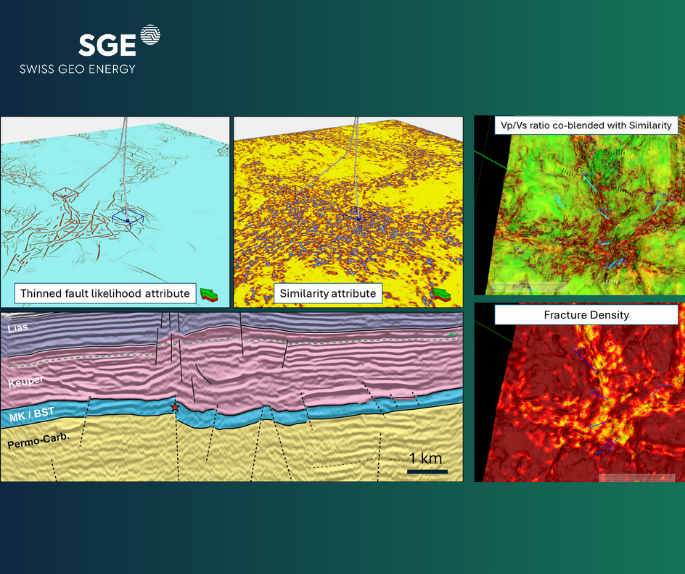
In September 2023, Swiss Geo Energy and Ad Terra Consultancy conducted an ambitious underground mapping project in the Eclépens region. Using seismic reflection technology — a method that sends sound waves deep into the earth to create images of underground rock layers — the team surveyed 104 km2 to support a deep geothermal energy project.
What is deep geothermal energy?
Deep geothermal energy harnesses heat stored naturally in rock formations thousands of meters below ground. Unlike shallow geothermal systems that heat and cool buildings, deep geothermal projects can generate electricity by tapping into extremely hot underground reservoirs.
Advanced underground imaging
The collected seismic data underwent sophisticated processing using two techniques:
- Conventional PreSDM (Prestack Depth Migration): A standard method for creating underground images, explained in a previous article
- ES360 angle-based migration: An advanced technique that provides more detailed views of rock properties at the depths where geothermal reservoirs typically exist.
The seismic interpretation phase is now complete. As part of a specialised study called AVAZ/VVAZ (Amplitude Versus Azimuth/Velocity Versus Azimuth), Ad Terra Consultancy’s and Swiss Geo Energy’s teams analysed how seismic waves behave differently depending on their direction and speed. This analysis revealed crucial elastic properties of the underground rocks, including:
- P-impedance: How resistant rocks are to seismic waves. Product of seismic velocity and density.
- Vp/Vs ratio: The relationship between different types of seismic wave speeds.
Finding fractures and fault zones
To locate areas where rocks are cracked or fractured — essential for geothermal fluid circulation — the team analysed multiple seismic characteristics:
- Similarity: How consistent the rock layers appear across different areas
- Thinned fault likelihood: The probability of finding geological faults (cracks in rock formations)
- Fracture density: How many cracks exist in a given rock volume
- Spectral decomposition: Breaking down seismic signals into different frequency components to reveal hidden geological features.
These analyses helped identify preliminary drilling targets — specific locations where geothermal wells might be most successful.
A comprehensive approach
This seismic work represents just one piece of a larger puzzle. The underground imaging results are being combined and cross-checked between several disciplines:
- Geophysical studies – Seismic interpretation and mapping, attribute extraction. Of particular interest is the mapping of deep geothermal objectives (Muschelkalk) below the massive salt pillows in Keuper (Upper Triassic).
- Petrophysical studies – Analysis of rock properties like porosity and permeability. For instance, analysis of Muschelkalk shows low matrix porosity; the geological objectives shall be focused on finding the fractured reservoir in fault damage zones. Another study showed that the critical factor for fracturing is the shale/marl content.
- Geomechanical studies – Understanding how rocks behave under stress and pressure, analysis of the kinematics to increase the chance of hitting a conductive fractured zone in relation to the regional/local stress ratio.
- Hydrogeological studies – Mapping underground water flow patterns, analysing the ways how a fractured reservoir can be refilled.
- Geological modelling – Creating detailed 3D models of the subsurface. The Eclepens model incorporates various inputs from other disciplines, including fault networks, seismo-lithological boundaries, and reservoir properties.
Together, these investigations form one of Switzerland’s most comprehensive underground assessments for geothermal development.
Safety first
Several critical tasks remain before drilling can begin. Seismotectonic analysis will evaluate earthquake risks, while hydrocarbon risk assessment will ensure the project avoids accidentally encountering oil or gas deposits. Additionally, environmental impact studies must be conducted to assess the potential effects on local ecosystems, groundwater, and surrounding communities. These safety and environmental measures aim to prevent incidents that have affected previous Swiss geothermal projects and are now closely monitored by the Swiss federal and cantonal institutions.
Looking ahead
The research team will present their findings at three upcoming conferences:
- SASEG Annual Convention (June 14-16, 2025, Basel)
“GeoCoGen Eclépens: Exploring targets in the light of 3D seismic results” (accepted) – https://www.saseg.ch/agenda (Takeaways will be soon presented on Ad Terra’s LinkedIn channel) - European Geothermal Congress 2025 (October 6-10, 2025, Zurich)
“Unlocking Geothermal Potential through 3D Seismic” (submitted) – https://europeangeothermalcongress.eu/ - Second EAGE Data Processing Workshop (October 6-8, 2025, Barcelona)
“Improved imaging using angle-dependent ray-based algorithms for 3D prestack depth migration” (submitted) – https://eage.eventsair.com/second-eage-data-processing-workshop/
We also thank the Federal Office of Energy (OFEN) for its financial support in the prospection phase.
The journey toward sustainable geothermal energy in Eclépens continues, with each analysis bringing us closer to understanding what lies beneath the surface.


